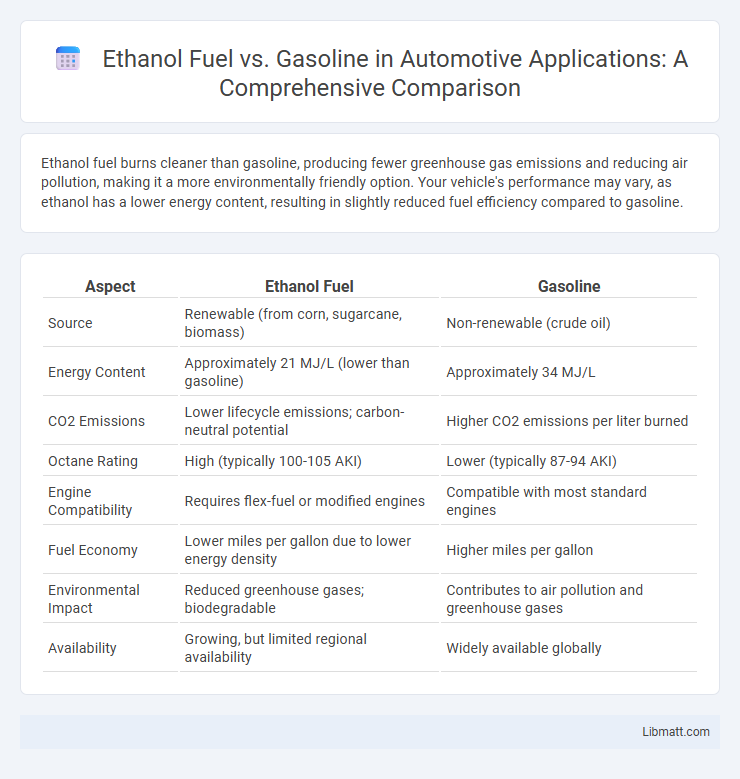Ethanol fuel burns cleaner than gasoline, producing fewer greenhouse gas emissions and reducing air pollution, making it a more environmentally friendly option. Your vehicle's performance may vary, as ethanol has a lower energy content, resulting in slightly reduced fuel efficiency compared to gasoline.
Table of Comparison
| Aspect | Ethanol Fuel | Gasoline |
|---|---|---|
| Source | Renewable (from corn, sugarcane, biomass) | Non-renewable (crude oil) |
| Energy Content | Approximately 21 MJ/L (lower than gasoline) | Approximately 34 MJ/L |
| CO2 Emissions | Lower lifecycle emissions; carbon-neutral potential | Higher CO2 emissions per liter burned |
| Octane Rating | High (typically 100-105 AKI) | Lower (typically 87-94 AKI) |
| Engine Compatibility | Requires flex-fuel or modified engines | Compatible with most standard engines |
| Fuel Economy | Lower miles per gallon due to lower energy density | Higher miles per gallon |
| Environmental Impact | Reduced greenhouse gases; biodegradable | Contributes to air pollution and greenhouse gases |
| Availability | Growing, but limited regional availability | Widely available globally |
Introduction to Ethanol Fuel and Gasoline
Ethanol fuel is a renewable biofuel derived primarily from corn and sugarcane, offering a cleaner-burning alternative to traditional gasoline. Gasoline, a fossil fuel refined from crude oil, is widely used for its high energy density and established infrastructure. Understanding the differences between ethanol and gasoline helps you make informed decisions about fuel efficiency, environmental impact, and compatibility with your vehicle.
Chemical Composition and Production Processes
Ethanol fuel consists primarily of C2H5OH molecules produced through the fermentation of biomass such as corn or sugarcane, making it a renewable biofuel. Gasoline is a complex mixture of hydrocarbons derived from crude oil through refining processes like distillation and cracking. Understanding the chemical makeup and production methods of ethanol versus gasoline helps you evaluate their environmental impacts and energy efficiency.
Energy Efficiency and Combustion Characteristics
Ethanol fuel exhibits lower energy density than gasoline, providing roughly 70% of the energy per gallon, which influences fuel economy and vehicle range. Its higher octane rating (typically 108 RON vs 87-94 RON for gasoline) promotes better combustion stability and reduced engine knocking, enabling higher compression ratios for improved performance. Ethanol's oxygen-rich composition enhances combustion efficiency and reduces carbon monoxide emissions, but it also demands engine calibration adjustments due to its different vaporization and flame propagation properties.
Environmental Impact: Emissions and Pollution
Ethanol fuel produces significantly lower carbon monoxide and particulate emissions compared to gasoline, resulting in reduced air pollution and improved overall air quality. Its renewable nature leads to decreased greenhouse gas emissions, making ethanol a more environmentally sustainable option than traditional fossil fuels. Using ethanol in your vehicle can contribute to lower levels of smog-causing pollutants and help combat climate change through a cleaner combustion process.
Cost Comparison and Market Availability
Ethanol fuel typically costs less per gallon than gasoline, partly due to subsidies and lower production expenses from renewable sources like corn or sugarcane. Gasoline remains more widely available at fueling stations across the U.S. and globally, ensuring easier access and compatibility with current vehicle technology. Market availability of ethanol is growing steadily, particularly in regions with supportive policies, but gasoline continues to dominate due to established supply chains and infrastructure.
Engine Performance and Compatibility
Ethanol fuel offers higher octane ratings, typically around 108, which can enhance engine performance by enabling higher compression ratios and reducing engine knocking compared to gasoline's octane ratings of 87 to 94. However, ethanol has a lower energy density, delivering about 33% less energy per gallon than gasoline, which may result in decreased fuel economy. Compatibility issues arise as ethanol can be corrosive to certain engine components and fuel systems not specifically designed for it, necessitating the use of flexible fuel vehicles (FFVs) or modifications for optimal operation.
Renewable vs. Non-Renewable Resources
Ethanol fuel is derived from renewable resources such as corn, sugarcane, and cellulosic biomass, allowing for sustainable production cycles that reduce carbon emissions. Gasoline, on the other hand, is a non-renewable fossil fuel extracted from crude oil reserves that are finite and contribute significantly to greenhouse gas emissions. The renewable nature of ethanol makes it a more environmentally friendly alternative to conventional gasoline in terms of resource availability and carbon footprint.
Impact on Vehicle Maintenance and Longevity
Ethanol fuel can cause increased wear on vehicle components such as fuel lines and injectors due to its corrosive nature and higher solvent properties compared to gasoline. Your vehicle's maintenance schedule may require more frequent inspections and replacements of parts when using ethanol-blended fuels, impacting longevity if not properly managed. Gasoline typically offers better engine durability and fewer compatibility issues, making it a more reliable choice for long-term vehicle performance.
Infrastructure Requirements and Distribution
Ethanol fuel requires modifications to existing infrastructure, including corrosion-resistant storage tanks and flexible fuel pumps, to accommodate its higher oxygen content and corrosive properties compared to gasoline. Distribution networks for ethanol demand blending terminals and dedicated transport systems to prevent contamination and ensure proper fuel mixtures, posing challenges unlike the established gasoline pipelines and stations. The higher volatility and hygroscopic nature of ethanol also necessitate stringent handling protocols and advanced logistics to maintain fuel quality during distribution.
Future Trends in Automotive Fuels
Ethanol fuel, derived from renewable biomass, is expected to play a growing role in reducing carbon emissions and enhancing energy security as automotive manufacturers develop flex-fuel vehicles capable of using higher ethanol blends like E85. Gasoline, while currently dominant due to established infrastructure and energy density advantages, faces increasing regulatory pressure to lower greenhouse gas emissions, driving innovations such as improved fuel formulations and hybrid technology integration. Your choice of vehicle fuel will become more influenced by region-specific policies favoring ethanol blends or advanced gasoline alternatives to meet stringent environmental standards.
ethanol fuel vs gasoline Infographic

 libmatt.com
libmatt.com